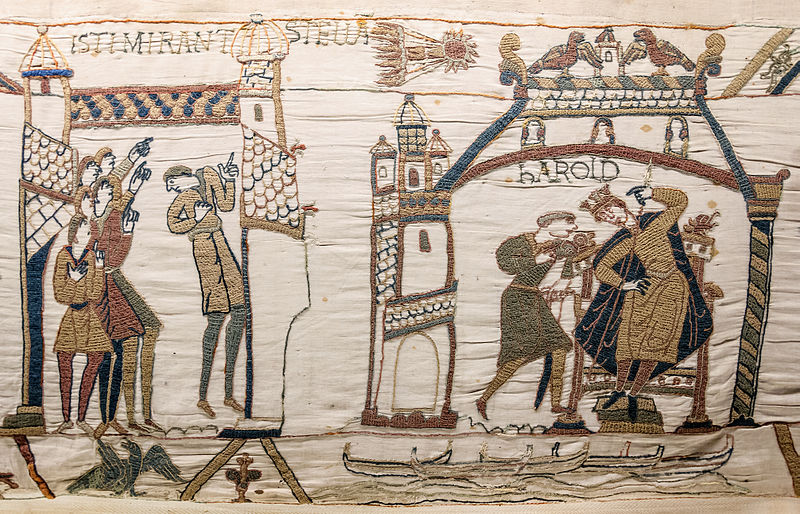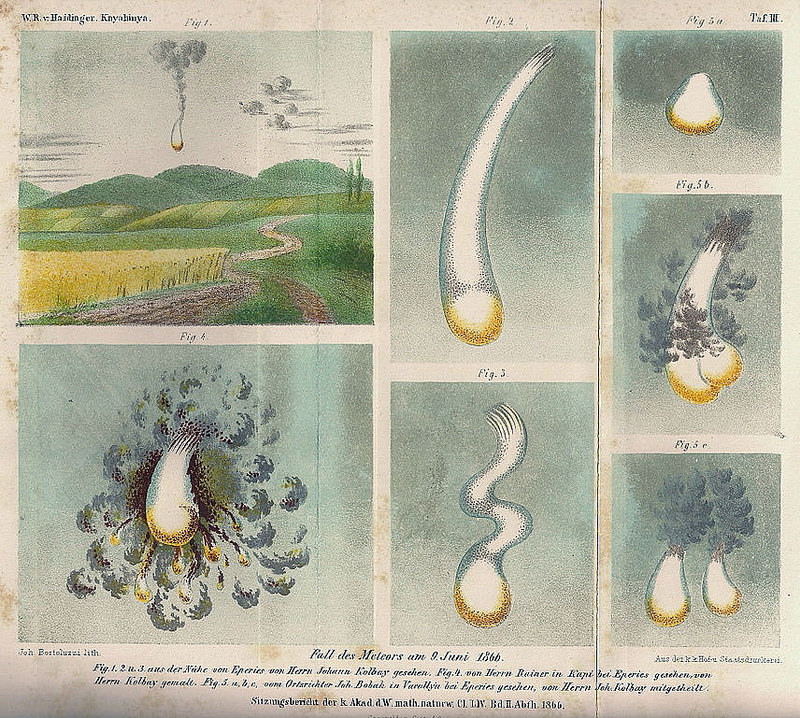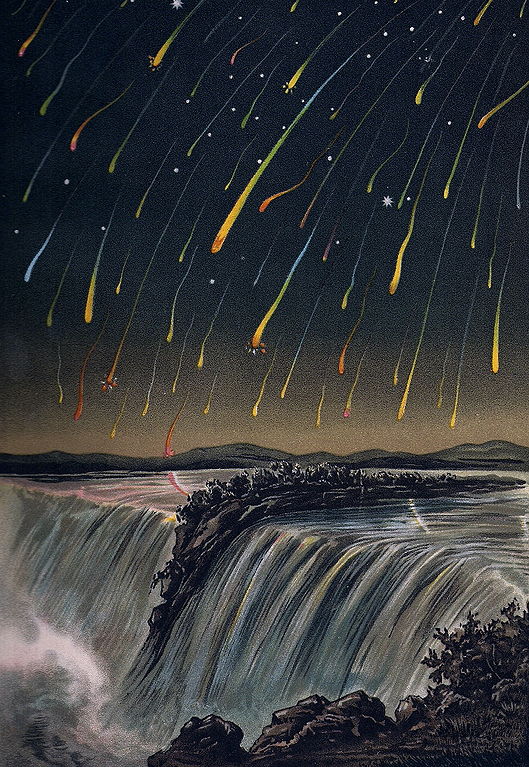Comets and meteorites through the eyes of scientists and artists of past centuries
What did people from the distant past think of celestial bodies?

Comet and the earthquake in Istanbul (1556)
Since ancient times, people have watched the sky and, of course, noticed unusual bright objects moving in the sky with great speed. Scientists of ancient Greece tried to find a logical explanation for what was happening. In the 4th century BC The Greek scientist Aristotle decided that comets are the ignition of air. Such ignitions occur due to the inhomogeneity of the air surrounding our planet, as a result of which flammable inclusions sometimes light up. In his opinion, perfect order reigned in heaven, harmony. Such an unexpected and accidental phenomenon, like a comet, could not be part of the sky. Aristotle considered the Milky Way and the product of air heating stars.
')
This opinion was rejected by other ancient Greek scientists. The Pythagoreans believed that comets are a kind of planets. Hippocrates of Chios claimed that the comet initially had no tail, it appears only after a long walk in space. But Seneca was already close to understanding what constitutes a comet. He wrote that comets move in elliptical orbits, and you can only see the comet at the lowest point of such an orbit. Seneca believed that some comets are returning with a period of about 70 years. “I cannot agree that a comet is only a lit fire; rather, it is one of the eternal creations of nature ... A comet has its own place between celestial bodies ..., it describes its path and does not go out, but only leaves. We will not be surprised that the laws of motion of comets have not yet been solved; the time will come when hard work will reveal the truth now hidden to us ... ”, wrote Seneca.
There were other opinions. Anaxagoras believed that the Sun, the Moon and the stars are rocks cut off from the Earth. His opinion at that time was confirmed by meteorites falling to the ground. In northern Greece, the land between 468th and 466 BC. a large meteorite fell (about the size of a cart, as described by eyewitnesses). It was a stone meteorite, which was considered proof of the point of view of Anaxagoras.
Ancient Greek scientists were practically the only supporters of the description of comets and meteorites as natural phenomena over a long period of time. Both before and after cosmic bodies were considered mystical objects. Someone assessed the passage of a comet, as a manifestation of the will of God, someone - as a precursor of future troubles. And since epidemics and wars at that time were a frequent occurrence, the appearance of comets was associated with them.
In addition to ancient Greek scientists, the Chinese also observed the movement of comets in the sky. They began observations a long time ago. The first in the history of the description of the comet is a written testimony of the Chinese, created in 2296 BC. Chinese scientists represented space differently than the ancient Greeks. According to the Chinese, the Universe is a huge empire, the head of which is the Sun. Our luminary is the emperor. Planets and bright stars are the rulers who gave instructions to comets. The latter played the role of couriers, scurrying around the cosmos, and conveying the necessary messages. The Chinese considered comets to be a good thing.
Later, comets began to be considered the harbinger of the death of the rulers and their heirs. For example, after the murder of Julius Caesar, a bright comet appeared in the sky. Comets appeared at the time of death (or shortly before / after) Ivan the Terrible, Constantine the Great, Pope Urban IV. Comets brought real horror to many rulers of the Middle Ages.
On medieval paintings, tapestries, frescoes, in manuscripts and engravings, the comet has been depicted repeatedly. Some artists depicted comets very accurately, without any “axes, knives, swords, covered with blood." As an example of one of the first images of comets, one can cite the tapestry of Baine, the most famous work of the Norman period of conquest in England (1066). Tapestry was created in 1070. Here you can see Halley's comet, depicted above King Harold II’s head. The comet was then considered the harbinger of impending disaster. The king probably had a lot of sleepless nights because the comet appeared on April 24, 1066, only 4 months after his coronation.

Tapestry Bayeux. You can see people pointing to a comet
As for the Slavs, for the first time information about comets appeared in the Tale of Bygone Years. In Kievan Rus, comets were also considered the harbingers of various misfortunes — war, plague, and other catastrophes. Interestingly, in ancient Russia, comets were considered to be moving tail stars. In the annals of the description of the comet fell in 1066. The following was written about this celestial body: “the star is great; the star of liberty, lutse imushi aky bloody, descending from evening on the setting of the sun; star image copy; the star ... emitting a beam, it is called Blastard. ”

Nuremberg Chronicles, 1493
Afraid of comets and ordinary people. Thus, the French surgeon Ambroise Pare described the comet in 1528 as follows:

Augsburger Wunderzeichenbuch, 1552.

The appearance of a comet in 1577, Georgium Jacobum von Datschitz

Image of the Scary Comet, Les oeuvres d'Ambroise Paré, 1579
The famous medieval physician and part-time alchemist Paracelsus claimed that comets are messengers of angels announcing death.

Image of a comet from Astronomie & Komet, 1580
But in the 16th century, scientists engaged in comets. Tycho Brahe and some other astronomers realized that comets are not an atmospheric phenomenon and not the hand of God. In fact, comets are outside the atmosphere and much farther away than the moon.

Detailed image of the comet, 1665
In the 1980s, comets began to study more thoroughly. The beginning of the study of comets in the new story put Edmond Galley. He first established the frequency of occurrence of one of the comets, which appeared in 1680, and calculated its orbit with the help of Newton.

Comet over Catalonia, 1704
After the first comet, Halley made orbit calculations for another 24 comets. These comets were recorded in the first catalog of the orbits of comets that appeared in 1531, 1607 and 1682. After the scientist calculated the parameters of the orbits of these comets, he found out that there are similar comet characteristics, and decided that these are not three, but one comet that appears at a frequency of 75.5 years. This celestial body was named Halley's comet. After the works of Newton and Halley, as well as the works of other scientists, comets ceased to be a mystery and became the subject of study of science.

Meteor shower in the night sky, 1783

Isobazhenie comet (Thomas Cornell, 1789)

JJ Grandville's Un Autre Monde (1844)

The theory of tails and shapes of comets was created at the end of the 19th century by the Russian scientist Fedor Bredikhin. He also developed the classification of cometary tails, which is used in modern astronomy. Bredikhin proposed to attribute the tails of comets to the main three types: straight and narrow, directed directly from the Sun; wide and slightly curved, deviating from the sun; short, strongly deviated from the central body.

Image of a falling meteorite (Ukraine, 1866)


Comet C / 1881 K1, 1881

Leonids, 1833

Photo of Comet Morehouse, Yerka Observatory, 1908
Nowadays, comets are not only studied with the help of astronomical instruments, spacecraft are sent to these celestial bodies. Probes created by humans visited comet 19P / Borelli, comet 81P / Wild, Halley’s comet, 26P / Grigg-Skjellerup, 21P / Giacobini-Zinner, 9P / Tempel, 103P / Hartley, 67P / Churyumova-Gerasimenko. In the past few years, the last mission was particularly actively covered, using the Rosetta station and the Philae probe. These two vehicles, which studied the comet Churyumov-Gerasimenko, gave a person a huge amount of information about the structure and origin of these celestial bodies. Processing and analysis of the data continues to this day.

Photo of Comet Churyumov-Gerasimenko taken by Rosetta station, 2015

Comet and the earthquake in Istanbul (1556)
Since ancient times, people have watched the sky and, of course, noticed unusual bright objects moving in the sky with great speed. Scientists of ancient Greece tried to find a logical explanation for what was happening. In the 4th century BC The Greek scientist Aristotle decided that comets are the ignition of air. Such ignitions occur due to the inhomogeneity of the air surrounding our planet, as a result of which flammable inclusions sometimes light up. In his opinion, perfect order reigned in heaven, harmony. Such an unexpected and accidental phenomenon, like a comet, could not be part of the sky. Aristotle considered the Milky Way and the product of air heating stars.
')
This opinion was rejected by other ancient Greek scientists. The Pythagoreans believed that comets are a kind of planets. Hippocrates of Chios claimed that the comet initially had no tail, it appears only after a long walk in space. But Seneca was already close to understanding what constitutes a comet. He wrote that comets move in elliptical orbits, and you can only see the comet at the lowest point of such an orbit. Seneca believed that some comets are returning with a period of about 70 years. “I cannot agree that a comet is only a lit fire; rather, it is one of the eternal creations of nature ... A comet has its own place between celestial bodies ..., it describes its path and does not go out, but only leaves. We will not be surprised that the laws of motion of comets have not yet been solved; the time will come when hard work will reveal the truth now hidden to us ... ”, wrote Seneca.
There were other opinions. Anaxagoras believed that the Sun, the Moon and the stars are rocks cut off from the Earth. His opinion at that time was confirmed by meteorites falling to the ground. In northern Greece, the land between 468th and 466 BC. a large meteorite fell (about the size of a cart, as described by eyewitnesses). It was a stone meteorite, which was considered proof of the point of view of Anaxagoras.
Ancient Greek scientists were practically the only supporters of the description of comets and meteorites as natural phenomena over a long period of time. Both before and after cosmic bodies were considered mystical objects. Someone assessed the passage of a comet, as a manifestation of the will of God, someone - as a precursor of future troubles. And since epidemics and wars at that time were a frequent occurrence, the appearance of comets was associated with them.
In addition to ancient Greek scientists, the Chinese also observed the movement of comets in the sky. They began observations a long time ago. The first in the history of the description of the comet is a written testimony of the Chinese, created in 2296 BC. Chinese scientists represented space differently than the ancient Greeks. According to the Chinese, the Universe is a huge empire, the head of which is the Sun. Our luminary is the emperor. Planets and bright stars are the rulers who gave instructions to comets. The latter played the role of couriers, scurrying around the cosmos, and conveying the necessary messages. The Chinese considered comets to be a good thing.
Later, comets began to be considered the harbinger of the death of the rulers and their heirs. For example, after the murder of Julius Caesar, a bright comet appeared in the sky. Comets appeared at the time of death (or shortly before / after) Ivan the Terrible, Constantine the Great, Pope Urban IV. Comets brought real horror to many rulers of the Middle Ages.
On medieval paintings, tapestries, frescoes, in manuscripts and engravings, the comet has been depicted repeatedly. Some artists depicted comets very accurately, without any “axes, knives, swords, covered with blood." As an example of one of the first images of comets, one can cite the tapestry of Baine, the most famous work of the Norman period of conquest in England (1066). Tapestry was created in 1070. Here you can see Halley's comet, depicted above King Harold II’s head. The comet was then considered the harbinger of impending disaster. The king probably had a lot of sleepless nights because the comet appeared on April 24, 1066, only 4 months after his coronation.

Tapestry Bayeux. You can see people pointing to a comet
As for the Slavs, for the first time information about comets appeared in the Tale of Bygone Years. In Kievan Rus, comets were also considered the harbingers of various misfortunes — war, plague, and other catastrophes. Interestingly, in ancient Russia, comets were considered to be moving tail stars. In the annals of the description of the comet fell in 1066. The following was written about this celestial body: “the star is great; the star of liberty, lutse imushi aky bloody, descending from evening on the setting of the sun; star image copy; the star ... emitting a beam, it is called Blastard. ”

Nuremberg Chronicles, 1493
Afraid of comets and ordinary people. Thus, the French surgeon Ambroise Pare described the comet in 1528 as follows:
“This comet was so terrible and terrible and caused so great confusion among the people that some died of fear alone, while others fell ill. She was a light of enormous length and bloody color; at the top of it was visible a clenched hand holding a long sword, as if ready to strike. At the end of his blade three stars were visible. On both sides of the rays emerging from the tail of this comet, there were a lot of axes, knives, swords, covered with blood, and among them were horrible human faces with disheveled beards and standing hair.

Augsburger Wunderzeichenbuch, 1552.

The appearance of a comet in 1577, Georgium Jacobum von Datschitz

Image of the Scary Comet, Les oeuvres d'Ambroise Paré, 1579
The famous medieval physician and part-time alchemist Paracelsus claimed that comets are messengers of angels announcing death.

Image of a comet from Astronomie & Komet, 1580
But in the 16th century, scientists engaged in comets. Tycho Brahe and some other astronomers realized that comets are not an atmospheric phenomenon and not the hand of God. In fact, comets are outside the atmosphere and much farther away than the moon.

Detailed image of the comet, 1665
In the 1980s, comets began to study more thoroughly. The beginning of the study of comets in the new story put Edmond Galley. He first established the frequency of occurrence of one of the comets, which appeared in 1680, and calculated its orbit with the help of Newton.

Comet over Catalonia, 1704
After the first comet, Halley made orbit calculations for another 24 comets. These comets were recorded in the first catalog of the orbits of comets that appeared in 1531, 1607 and 1682. After the scientist calculated the parameters of the orbits of these comets, he found out that there are similar comet characteristics, and decided that these are not three, but one comet that appears at a frequency of 75.5 years. This celestial body was named Halley's comet. After the works of Newton and Halley, as well as the works of other scientists, comets ceased to be a mystery and became the subject of study of science.

Meteor shower in the night sky, 1783

Isobazhenie comet (Thomas Cornell, 1789)

JJ Grandville's Un Autre Monde (1844)

The theory of tails and shapes of comets was created at the end of the 19th century by the Russian scientist Fedor Bredikhin. He also developed the classification of cometary tails, which is used in modern astronomy. Bredikhin proposed to attribute the tails of comets to the main three types: straight and narrow, directed directly from the Sun; wide and slightly curved, deviating from the sun; short, strongly deviated from the central body.

Image of a falling meteorite (Ukraine, 1866)


Comet C / 1881 K1, 1881

Leonids, 1833

Photo of Comet Morehouse, Yerka Observatory, 1908
Nowadays, comets are not only studied with the help of astronomical instruments, spacecraft are sent to these celestial bodies. Probes created by humans visited comet 19P / Borelli, comet 81P / Wild, Halley’s comet, 26P / Grigg-Skjellerup, 21P / Giacobini-Zinner, 9P / Tempel, 103P / Hartley, 67P / Churyumova-Gerasimenko. In the past few years, the last mission was particularly actively covered, using the Rosetta station and the Philae probe. These two vehicles, which studied the comet Churyumov-Gerasimenko, gave a person a huge amount of information about the structure and origin of these celestial bodies. Processing and analysis of the data continues to this day.

Photo of Comet Churyumov-Gerasimenko taken by Rosetta station, 2015
Source: https://habr.com/ru/post/369457/
All Articles